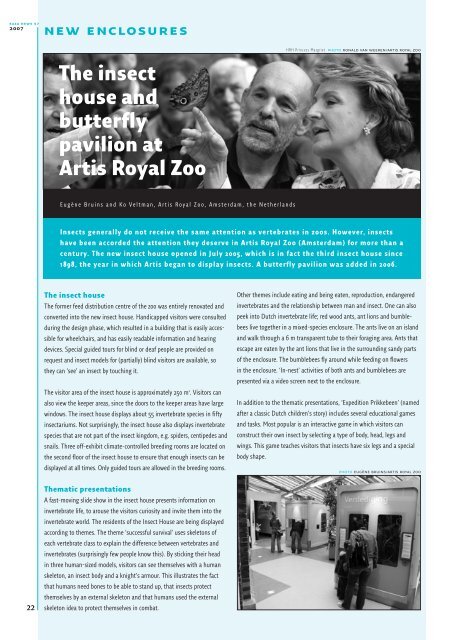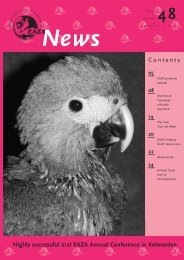EAZA News 57-12 - European Association of Zoos and Aquaria
EAZA News 57-12 - European Association of Zoos and Aquaria
EAZA News 57-12 - European Association of Zoos and Aquaria
Create successful ePaper yourself
Turn your PDF publications into a flip-book with our unique Google optimized e-Paper software.
eaza news <strong>57</strong><br />
2007<br />
22<br />
new enclosures<br />
The insect<br />
house <strong>and</strong><br />
butterfly<br />
pavilion at<br />
Artis Royal Zoo<br />
Eugène Bruins <strong>and</strong> Ko Veltman, Artis Royal Zoo, Amsterdam, the Netherl<strong>and</strong>s<br />
The insect house<br />
The former feed distribution centre <strong>of</strong> the zoo was entirely renovated <strong>and</strong><br />
converted into the new insect house. H<strong>and</strong>icapped visitors were consulted<br />
during the design phase, which resulted in a building that is easily accessible<br />
for wheelchairs, <strong>and</strong> has easily readable information <strong>and</strong> hearing<br />
devices. Special guided tours for blind or deaf people are provided on<br />
request <strong>and</strong> insect models for (partially) blind visitors are available, so<br />
they can ‘see’ an insect by touching it.<br />
The visitor area <strong>of</strong> the insect house is approximately 250 m2 . Visitors can<br />
also view the keeper areas, since the doors to the keeper areas have large<br />
windows. The insect house displays about 55 invertebrate species in fifty<br />
insectariums. Not surprisingly, the insect house also displays invertebrate<br />
species that are not part <strong>of</strong> the insect kingdom, e.g. spiders, centipedes <strong>and</strong><br />
snails. Three <strong>of</strong>f-exhibit climate-controlled breeding rooms are located on<br />
the second floor <strong>of</strong> the insect house to ensure that enough insects can be<br />
displayed at all times. Only guided tours are allowed in the breeding rooms.<br />
Thematic presentations<br />
A fast-moving slide show in the insect house presents information on<br />
invertebrate life, to arouse the visitors curiosity <strong>and</strong> invite them into the<br />
invertebrate world. The residents <strong>of</strong> the Insect House are being displayed<br />
according to themes. The theme ‘successful survival’ uses skeletons <strong>of</strong><br />
each vertebrate class to explain the difference between vertebrates <strong>and</strong><br />
invertebrates (surprisingly few people know this). By sticking their head<br />
in three human-sized models, visitors can see themselves with a human<br />
skeleton, an insect body <strong>and</strong> a knight’s armour. This illustrates the fact<br />
that humans need bones to be able to st<strong>and</strong> up, that insects protect<br />
themselves by an external skeleton <strong>and</strong> that humans used the external<br />
skeleton idea to protect themselves in combat.<br />
HRH Princess Margriet photo ronald van weeren/artis royal zoo<br />
Insects generally do not receive the same attention as vertebrates in zoos. However, insects<br />
have been accorded the attention they deserve in Artis Royal Zoo (Amsterdam) for more than a<br />
century. The new insect house opened in July 2005, which is in fact the third insect house since<br />
1898, the year in which Artis began to display insects. A butterfly pavilion was added in 2006.<br />
Other themes include eating <strong>and</strong> being eaten, reproduction, endangered<br />
invertebrates <strong>and</strong> the relationship between man <strong>and</strong> insect. One can also<br />
peek into Dutch invertebrate life; red wood ants, ant lions <strong>and</strong> bumblebees<br />
live together in a mixed-species enclosure. The ants live on an isl<strong>and</strong><br />
<strong>and</strong> walk through a 6 m transparent tube to their foraging area. Ants that<br />
escape are eaten by the ant lions that live in the surrounding s<strong>and</strong>y parts<br />
<strong>of</strong> the enclosure. The bumblebees fly around while feeding on flowers<br />
in the enclosure. ‘In-nest’ activities <strong>of</strong> both ants <strong>and</strong> bumblebees are<br />
presented via a video screen next to the enclosure.<br />
In addition to the thematic presentations, ‘Expedition Prikkebeen’ (named<br />
after a classic Dutch children’s story) includes several educational games<br />
<strong>and</strong> tasks. Most popular is an interactive game in which visitors can<br />
construct their own insect by selecting a type <strong>of</strong> body, head, legs <strong>and</strong><br />
wings. This game teaches visitors that insects have six legs <strong>and</strong> a special<br />
body shape.<br />
photo eugène bruins/artis royal zoo

















